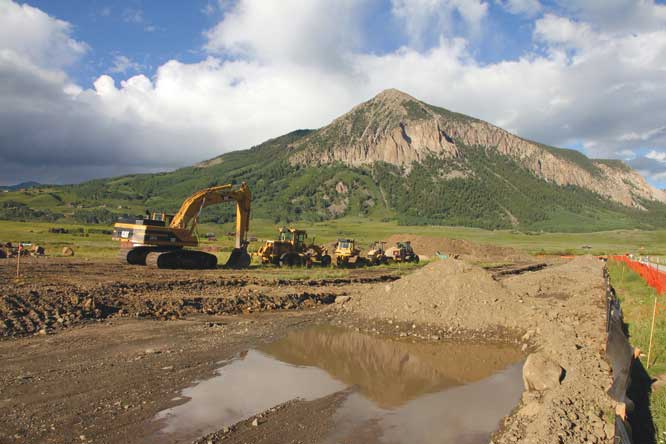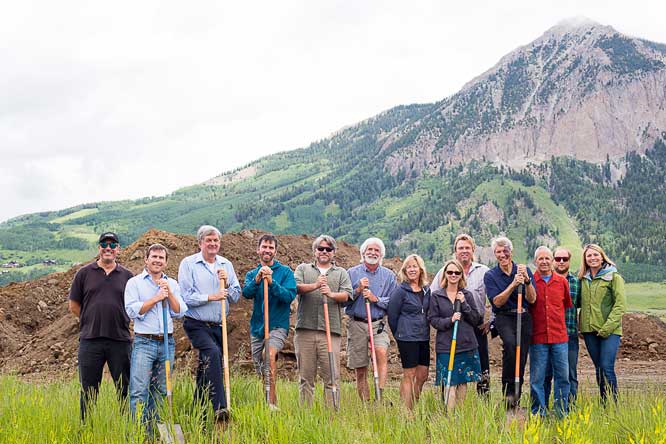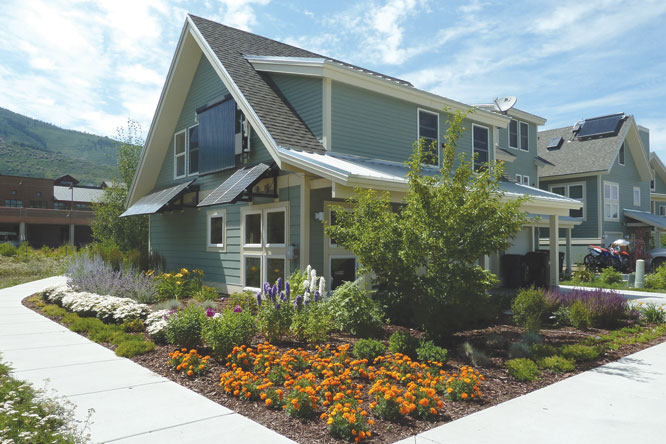By Adam Broderick
Editor’s note: There is more to living in a resort town than the difficulty of finding a place to live or the long political discussion over how to provide so-called affordable housing. Reporter Adam Broderick will look at different angles of the issue in this summer series that explores what it’s actually like to live in deed-restricted affordable housing in Crested Butte and Mt. Crested Butte.
This week we take a glimpse into current residents’ living situations, exploring different deed-restricted neighborhoods and their advantages and disadvantages as residents view them.
A handful of deed-restricted affordable homeowners from the Upper Gunnison Valley explained what they thought about their living situations. From Red Lady Estates to Paradise Park and Poverty Gulch on either side of town to Prospect on the back side of the mountain, this is what people really think of their affordable homes.
Paradise Park
Nicky O’Connor lives with her dog and cat in the Paradise Park community, which is located on the block between Gothic and Teocalli and 8th and 9th streets. She moved into her one-bed, 1.5-bath condo with a garage in June 2007 after building the house through the winter months as part of the Mutual Self-Help Build, a program offered by the Gunnison Valley Regional Housing Authority.

photo by Adam Broderick
Four units were built simultaneously—two buildings, two townhomes in each—and all homeowners pitched in to help each other build and save money up front.
In lieu of a down payment they were required to work a minimum of 30 hours per week, but many worked more than that. O’Connor says homeowners collectively did about 60 percent of the builds and contracted out the plumbing, drywall, roofing and the initial concrete pour. They did all other flooring aspects themselves, including grouting, staining and sealing.
“We would do one step on someone’s house all the way through, then repeat that step in the other homes. When it came to the inside—personal stuff like paint choices and interior designs [O’Connor was quick to engrave a Celtic knot on the floor]—we would do our own,” she says. “We worked over the span of about nine months for at least 30 hours per week. Some weeks we put more time in. We were allowed to get help from friends or family, but we personally had to put at least 15 of those hours in. I ended up having to quit my second job to allow the time for the build.”
With rental rates as high as they have been lately, O’Connor says she couldn’t even get a room in town for the price she pays for her home. And when she walks out her front door, Mt. Crested Butte is the first thing she sees. In fact, she can see a peak out of each of her 16 windows. She lives next to the rec path, and says her neighbors are awesome. “We all help each other out,” she says. “And I love my little yard. It’s not fenced in but could be if I wanted.
“Another awesome thing about the program was how much I learned building the house from the ground up,” she continued. “I was able to add thoughts to the design of the original floor plan and change it up a bit. And I now have bragging rights because I can say I built my own house.”
As for downsides, O’Connor says there aren’t many other than resale value. “There is a cap on how much you can make on resale. My subsidized loan is through the United States Department of Agriculture. Even with the annual appreciation, if I were to sell I wouldn’t make much off of it.”
Red Lady Estates
Jack Gibbons lives in what he calls the best lot in town. His home is in the Red Lady Estates, the small mobile home community on Red Lady Avenue next to Clark’s Market, and he says he’s made it into something pretty incredible. Once you step inside, all the remodeling he’s done makes you forget you’re even in a mobile home. Even from the outside, it’s still difficult to tell.
Gibbons owns a 1,100-square-foot two-bedroom, two-bathroom home with one roommate, his cat and his roommate’s dog. He was lucky to find his home twenty years ago, when he says the town offered lots to people who were lucky enough to have their names drawn from a hat.
“I was number ten out of 50 people,” Gibbons says. “They gave you the lot and you went and bought a trailer. There were lots of hurdles and it was hard to come up with the down payment, but I don’t think it was atypical of what anyone else goes through. The home was relatively cheap. I’m so lucky to have been here at the perfect time, to have won the lottery that put me here.”
He moved into his new home, part of the first affordable housing project Crested Butte had done, in 1995. “At the beginning there was a lot of controversy, but I think we’ve proved everyone wrong,” he says. “People said they didn’t want a trailer park in town and called it degrading and white trash. I hate the term ‘trailer park.’ We try to keep the place clean and tidy as possible. I think it’s the best lot in town.”
Gibbons says the only downsides to his deed-restricted home are that he will never have a garage, just a porch over his front steps, and since he’s tucked up against The Bench he only gets a few hours of sun per day in the winter. But in summer the whole yard is a lush garden with water features and stone sitting areas, and the yard borders a hillside covered in thick foliage. “It’s a little oasis back there,” he says.
Poverty Gulch
Jake Jones and his family live in a two-bedroom, one-bath, 800+ square foot duplex in the Poverty Gulch community, which is on the north side of Butte Avenue between 7th and 8th streets. He says his wife, Sarah, holds the title as the first and only owner and if he remembers correctly, she won a lottery and was able to purchase their home from the town of Crested Butte in 1999 or 2000. Jones says the property was probably at one point considered unusable land, but was turned into affordable housing.
The Jones family most appreciates the price, convenient in-town location and great views from their home. They feel fortunate to live in town, especially since many of his and Sarah’s friends have moved their families out of town.
“We feel very fortunate to go non-motorized so often, leaving the car parked and riding bikes to work or a free bus to the ski area. Living in town, that’s really something,” Jones says. “Another upside is these units are owner-occupied. If we lived anywhere else in town, we’d probably be surrounded by renters. Living with other people who own their units is a good thing.”
In that corner of town, due to the density of affordable units, there are many long-term residents and families. According to Jones, “There is a strong sense of community, more so than in other parts of town where you find mostly renters or mostly dark neighborhoods. Also, our kid can ride his bike to school easily. His friends are all throughout the neighborhood. A lot of these families would not live in town if it weren’t for these units.”
Jones says about 15 years ago the town built the homes, then sold them. “People had to qualify, then get their name on a list, then have their name drawn. My wife had to meet all the standards of not making too much money, all the money she did make had to be locally earned and she had to have lived in the valley a certain number of years.”
Other than actual quality of life, Jones says there is no benefit to improving the property. Projects that require building permits—decks, windows, etc.—could add equity to the home, but not for many years. “A tiny 50-square foot addition could add $30,000, but you may not see that for 30 years,” he says. “[Improvement projects] may increase your quality of life, but you couldn’t recoup that as an investment.
“At the end of the day, these units do not get people out of affordable housing into the free market,” he continued. “The free market is far surpassed. But it is an affordable way for locals to experience homeownership.”
Prospect
Mark Fontenot says the town of Mt. Crested Butte was very generous and let him rent his one-bed, 1.5-bath in Prospect for a year to see if he liked the location. He bought it a year later. The Prospect development is on the backside of CBMR near the Prospect chairlift. Fontenot says he got into his home at just the right time and he is proud to have his own little slice of heaven for the rest of his life.
As far as restrictions go, Fontenot says he thinks the town hit a home run with the Prospect development. “Our dues are very low compared to other affordable housing communities around here and as far as wanting to do anything I can, as long as I go through the right steps and properly approach the board [of directors], I have had zero problems doing anything I’ve wanted to do. I can plant as much as I want and make my house look as beautiful as I want as long as I ask permission to do it. If I want to put granite countertops in my home, I can, and that adds to the value of my home. Any improvements I put into it I can get back.”
Fontenot explained that he could sell his house for the original cost plus around 3 to 3.5 percent (inflation, he called it) per year plus the cost of improvements he makes to it. “Whatever the house was purchased for, the next year it will increase 3 to 3.5 percent plus any improvements I do. If the granite counter tops cost $1,000 I can sell my house for cost plus 3.5 percent per year plus the $1,000 for the counter tops. You just keep your receipt.”
“I really hope we can build more of these opportunities for other people so they can have the same satisfaction I have,” he continued. “This town needs it. My home is affordable. I’m able to live in this amazing community and pay all my bills and not struggle to live here like some other people who aren’t as fortunate. I look forward to the day that Prospect is further built out so that I have more friends as neighbors.”
As you can see, these real life stories are examples of how affordable housing works. These communities are full of families, the local workforce—real Buttians. Stay tuned for the next installment of Living the Resort Town Life. We’ll take a look inside more affordable housing developments around town and explore what has been done in other resort towns to address local housing issues.
 The Crested Butte News Serving the Gunnison Valley since 1999
The Crested Butte News Serving the Gunnison Valley since 1999










